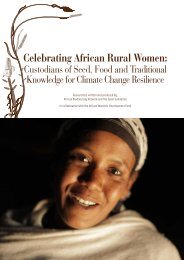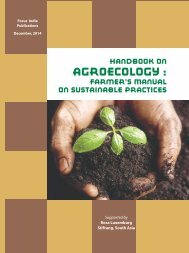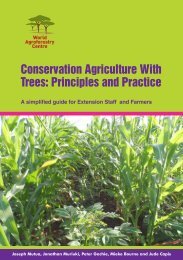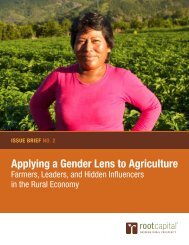1t0SC7l
1t0SC7l
1t0SC7l
Create successful ePaper yourself
Turn your PDF publications into a flip-book with our unique Google optimized e-Paper software.
Cucumeropsis mannii is grown following bush and forest fallow. The yields were 188 and 156<br />
kg / ha following bush fallow and forest fallow respectively (Table 2.11).<br />
Total land equivalent ratio (LER) for maize, groundnut, cassava, cocoyam in association was<br />
higher than for individual crops at all three fallow ages; indicating that the practice of<br />
association is advantageous compared to solid cropping of each of the crops. The LER<br />
decreased with the increase in fallow age.<br />
Table 2.10. Density and yield of cassava grown following natural fallow of different ages<br />
Fallow type<br />
(age)<br />
Density (plants / ha) Root fresh weight yield (ton / ha) Land equivalent ratio (LER)<br />
CF (3-5 yrs) 2300 17.85 0.23<br />
BF (6-9 yrs) 2310 16.43 0.23<br />
Sample size n = 18<br />
Table 2.11. Yield of Cucumeropsis mannii grown following natural fallow of different ages<br />
Fallow type (age) Density (plants / ha) Yield (kg / ha) Land equivalent ratio (LER)<br />
BF (6-9 yrs) 1950. 188 n.a.<br />
FF (>10 yrs) 1770 156 n.a.<br />
Sample size n = 4. n.a. = not available<br />
Land preparation. Manual labour dominates land preparation. The use of chainsaw reduces<br />
labour input only for ‘ngon’ field. All other operations remain manual. Two systems of land<br />
preparation are common in the area:<br />
- Forest or bush fallow is cleared with chainsaw or axe and cutlass for ‘ngon’ field<br />
establishment. Felled tree stems are left in the field and start to rot during the time ‘ngon’ is<br />
grown. One year later, after ‘ngon’ has been harvested, systematic clearing and burning take<br />
place for groundnut field establishment and later for cassava growing, then a Chromolaena<br />
fallow follows. Tilling using hoe is done simultaneously with the planting of groundnut and<br />
cassava. Forest and bush clearing is a man’s job. Women who cannot rely on men, hire<br />
labourers to prepare larger fields, or do it themselves to end up with smaller size fields.<br />
- Chromolaena fallow clearing 3 to 5 years after forest or bush fallow clearing, requires less<br />
labour; only cutlass and hoe could be used; therefore, women alone may do it. On sandy<br />
soils the roots are pulled out by hand. This tills the soil and further tillage with the hoe is<br />
only done for seeding.<br />
Clearing constitutes the basic operation for all cropping systems. It is performed between<br />
December-November for ‘Essep’, the first season planting and in May-June for ‘Oyon’, the<br />
second season planting and in October - November for ‘Assan’ the dry season swamp or valley<br />
bottom planting.<br />
Tillage is done for all types of field, except for the ‘ngon’ field and the solid stand of maize.<br />
Some farmers sow maize before tilling the land. Low tillage is common practice because of the<br />
shallow nature of forest soil (less than 12 cm deep). Moreover, farmers experience difficulties<br />
during tilling due to the presence of many roots in the soil. Before tilling, the plant debris lying<br />
on field must be cleared and burned.<br />
Seeding and planting. The period for seeding and planting may extend over three months in the<br />
same field and is mostly done at the same time as tillage with hoe. This work is nearly always<br />
done by women and children. Land preparation as a combination of clearing, cleaning, burning<br />
and tilling (see Figure 2.2 determines field size and production potentials.<br />
Seeds, planting materials and storage. The use of seed and cuttings from the farmer’s own farm<br />
is the common practice. The storage of seeds and planting materials is limited by space and<br />
inadequate post-harvest technology. Problems caused by insect, bird and rodent attacks are<br />
common. Grains are stored in the house near the fireplace, where smoke hinders insect attacks.<br />
19








